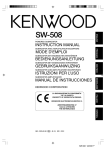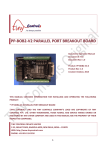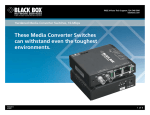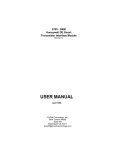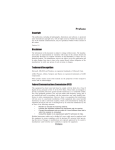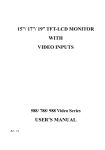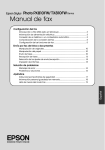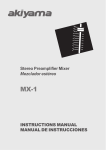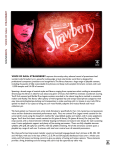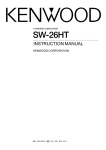Download Kenwood SW-508 Speaker User Manual
Transcript
ENGLISH SW-508 POWERED SUBWOOFER INSTRUCTION MANUAL KENWOOD CORPORATION B61-1229-00 00 MA (Y) KW 0312 SW-508 1229/01/EN Before applying power Caution: Read this page carefully to ensure safe operation. Units are designed for operation as follows. ENGLISH Europe and U.K. ................................................ AC 230V only Australia ............................................................ AC 240V only Other countries .......................... AC 110-120 / 220-240 V only switchable* * AC voltage selection The AC voltage selector switches on the rear panel are set to the voltage that prevails in the area to which the unit is shipped. Before connecting the power cord to your AC outlet, make sure that the setting positions of these switches match your line voltage. If not, they must be set to your voltage in accordance with the following direction. CAUTION The power in this equipment will not be completely cut off from the AC wall outlet when the main switch is turned OFF. AC voltage selector switches Move switch lever to match your line voltage with a small screwdriver or other pointed tool. AC220-240 AC110-120 Note: Our warranty does not cover damage caused by excessive line voltage due to improper setting of the AC voltage selector switch. Safety precautions WARNING : TO PREVENT FIRE OR ELECTRIC SHOCK, DO NOT EXPOSE THIS APPLIANCE TO RAIN OR MOISTURE. CAUTION RISK OF ELECTRIC SHOCK DO NOT OPEN CAUTION: TO REDUCE THE RISK OF ELECTRIC SHOCK, DO NOT REMOVE COVER (OR BACK). NO USER-SERVICEABLE PARTS INSIDE. REFER SERVICING TO QUALIFIED SERVICE PERSONNEL. THE LIGHTNING FLASH WITH ARROWHEAD SYMBOL, WITHIN AN EQUILATERAL TRIANGLE, IS INTENDED TO ALERT THE USER TO THE PRESENCE OF UNINSULATED “DANGEROUS VOLTAGE” WITHIN THE PRODUCT’S ENCLOSURE THAT MAY BE OF SUFFICIENT MAGNITUDE TO CONSTITUTE A RISK OF ELECTRIC SHOCK TO PERSONS. THE EXCLAMATION POINT WITHIN AN EQUILATERAL TRIANGLE IS INTENDED TO ALERT THE USER TO THE PRESENCE OF IMPORTANT OPERATING AND MAINTENANCE (SERVICING) INSTRUCTIONS IN THE LITERATURE ACCOMPANYING THE APPLIANCE. Introduction Thank you for selecting our speakers as part of your high-fidelity system. We at KENWOOD are confident that your choice will bring you years of rich listening pleasure. Please take the time to read through this booklet carefully. It will help you to obtain the peak performance for which the speakers were designed. For your records Record the serial number, found on the back of the unit, in the spaces designated on the warranty card, and in the space provided below. Refer to these model and serial numbers whenever you call upon your KENWOOD dealer for information or service on this product. SW-508 Serial number Unpacking Unpack the unit carefully and make sure that all accessories are put aside so they will not be lost. Examine the unit for any possibility of shipping damage. If your unit is damaged or fails to operate, notify your dealer immediately. If your unit was shipped to you directly, notify the shipping company without delay. Only the consignee (the person or company receiving the unit) can file a claim against the carrier for shipping damage. We recommend that you retain the original carton and packing materials for use should you transport or ship the unit in the future. Keep this manual handy for future reference. 2 EN SW-508 1229/02-08/EN IMPORTANT SAFEGUARDS Caution: Read this page carefully to ensure safe operation. 10. Lightning – For added protection for this appliance during a lightning storm, or when it is left unattended and unused for long periods of time, unplug it from the wall outlet and disconnect the antenna or cable system. This will prevent damage to the appliance due to lightning and power-line surges. 1. Power sources – The appliance should be connected to a power supply only of the type described in the instruction manual or as marked on the appliance. If you are not sure of the type of power supply to your home, consult your appliance dealer or local power company. For appliances intended to operate from battery power, or other sources, refer to the instruction manual. 11. Abnormal smell – If an abnormal smell or smoke is detected, immediately turn the power OFF and unplug the appliance from the wall outlet. Contact your dealer or nearest service center. 2. Power-cord protection – Power-supply cords should be routed so that they are not likely to be walked on or pinched by items placed upon or against them, pay particular attention to cords at plugs, convenience receptacles, and the point where they exit from the appliance. 3. Ventilation – Slots and openings in the cabinet are provided for ventilation and to ensure reliable operation of the appliance and to protect it from overheating, and these openings must not be blocked or covered. The appliance should be situated so that its location or position does not interfere with its proper ventilation. To maintain good ventilation, do not put records or a table-cloth on the appliance. Place the appliance at least 10 cm away from the walls. Do not use the appliance on a bed, sofa, rug or similar surface that may block the ventilation openings. This appliance should not be placed in a built-in installation such as a bookcase or rack unless proper ventilation is provided or the manufacturer’s instructions have been adhered to. 4. Water and moisture – The appliance shall not be exposed to dripping and splashing - for example, near a bathtub, washbowl, kitchen sink, laundry tub, in a wet basement, or near a swimming pool, etc. Do not place an object containing liquid, such as a flower vase, on the appliance. 5. Temperature – The appliance may not function properly if used at extremely low, or freezing temperatures. The ideal ambient temperature is above +5°C (41°F). 6. Heat – The appliance should be situated away from heat sources such as radiators, heat registers, stoves, or other appliances (including amplifiers) that produce heat. Do not place a flaming object, such as a candle or lantern, on or near the appliance. 7. Electric shock – Care should be taken so that objects do not fall and liquid is not spilled into the enclosure through openings. If a metal objects, such as a hair pin or a needle, comes into contact with the inside of this appliance, a dangerous electric shock may result. For families with children, never permit children to put anything, especially metal, inside this appliance. 8. Enclosure removal – Never remove the enclosure. If the internal parts are touched accidentally, a serious electric shock might occur. 12. Damage requiring service – The appliance should be serviced by qualified service personnel when: A. The power-supply cord or the plug has been damaged. B. Objects have fallen, or liquid has been spilled into the appliance. C. The appliance has been exposed to rain or water. D. The appliance does not appear to operate normally by following the instruction manual. Adjust only those controls that are covered by the instruction manual as an improper adjustment of other controls may result in damage and will often require extensive work by a qualified technician to restore the appliance to its normal operation. E. The appliance has been dropped, or the enclosure damaged. F. The appliance exhibits a marked change in performance. 13. Servicing – The user should not attempt to service the appliance beyond that described in the instruction manual. All other servicing should be referred to qualified service personnel. 14. Power lines – An outside antenna system should not be located in the vicinity of overhead power lines or other electric light or power circuits, or where it can fall into such power lines or circuits. When installing an outside antenna system, extreme care should be taken to keep from touching such power lines or circuits as contact with them might be fatal. 15. AC outlets – Do not connect other audio equipment with a power consumption larger than that specified to the AC outlet on the rear panel. Never connect other electrical appliances, such as an iron or toaster, to it to prevent fire or electric shock. 16. Overloading – Do not overload wall outlets, extension cords, or integral convenience receptacles as this can result in a risk of fire or electric shock. 17. Attachment – Do not use attachments not recommended by the appliance manufacturer as they may cause hazards. 18. Replacement parts – When replacement parts are required, be sure the service technician has used replacement parts specified by the manufacturer or have the same characteristics as the original parts. Unauthorized substitutions may result in fire, electric shock, or other hazards. 19. Safety check – Upon completion of any service or repairs to this appliance, ask the service technician to perform safety checks to determine that the appliance is in proper operating condition. 9. Cleaning – Unplug this appliance from the wall outlet before cleaning. Do not use volatile solvents such as alcohol, paint thinner, gasoline, or benzine, etc. to clean the cabinet. Use a clean dry cloth. 3 EN SW-508 1229/02-08/EN ENGLISH Please read all of the safety and operating instructions before operating this appliance. Adhere to all warnings on the appliance and in the instruction manual. Follow all the safety and operating instructions. These safety and operating instructions should be retained for future reference. Contents carefully to ensure safe operation. Before applying power ............................................................................................................................................................ Safety precautions .................................................................................................................................................................. Introduction .................................................................................................................................................................................... IMPORTANT SAFEGUARDS ................................................................................................................................................... Installation ...................................................................................................................................................................................... Connections ................................................................................................................................................................................... Controls and indicators .................................................................................................................................................................. Specifications ................................................................................................................................................................................. 2 2 2 3 4 5 7 8 Accessories Pin-plug cord ............... 1 Cushion .............. 4 (1 sheet) Attaching the cushions Attach four cushions to the base of the subwoofer, one at each corner. The cushions prevent the subwoofer from sliding, and dampen its vibrations. Installation The Subwoofer is a virtually omnidirectional speaker, so it can be installed in almost any location. For example, the Subwoofer can be installed next to the component system (consisting of an amplifier, tuner, cassette deck, etc.), or in a corner of the room, etc.. The subwoofer’s deep-bass reproduction characteristics are richest when the subwoofer is installed in a corner or near a wall. Since the low-bass component in music is usually monaural, only one subwoofer is necessary to obtain a sufficient stereo effect when used in combination with a stereo music system. Wall Wall Near the wall B Far from the wall C A Near the corner Howling If the Subwoofer is installed near an analog record turntable, a howling sound may be generated. If this occurs, place the Subwoofer farther away from the turntable or reduce the Subwoofer volume (By rotating the VOLUME control counterclock-wise). The howling phenomenon may also occur due to cross interference with a cassette deck, compact disc player, or Laserdisc player, although this is very rare. If sound or picture seems to be distorted due to this reason, place the Subwoofer farther away from other components or reduce its volume. Operation near a TV If the Subwoofer is installed near a TV set, the TV reception may be affected and interfered with color irregularities. Should color irregularities observed on TV screen, separate the Subwoofer from the TV until its reception becomes normal. Caution Speaker installation position, viewed from above A Sound Pressure Level ENGLISH Caution: Read the pages marked Near the corner B Near the wall C Far from the wall To assure ventilation, observe the follow- Vertical installation ing points when installing the unit. • Leave a distance of more than 10 cm between the Subwoofer back and the surrounding wall(s). Use special care not to cover the heat sink with a curtain, etc. when installing. • Be sure to install the Subwoofer vertically. Frequency 4 EN SW-508 1229/02-08/EN Connections Before connecting CAUTION 1 Set the POWER switches of the amplifier or receiver and Subwoofer to OFF. If they are connected with the POWER switch(es) left ON, one or both components may be damaged. SPEAKER INPUT L R L AUTO SHUT OFF ON SPEAKER OUTPUT 3 OFF LINE INPUT 2 1 SPEAKER INPUT terminals Connect to the speaker output terminals on your amplifier or receiver. 2 SPEAKER OUTPUT terminals These terminals output the signal received at the SPEAKER INPUT terminals. You can use them to relay the signla to your front speakers. 3 LINE INPUT jack This jack is used to connect the subwoofer Preout jack of the amplifier or receiver. 4 4 Power cord Connect to AC outlet. You can connect the subwoofer to your amplifier or receiver in one of ways, as described below. Refer to the indicated page for connection instructions. If your amplifier or receiver includes a Subwoofer Preout jack; If your amplifier or receiver does not include a Subwoofer Preout jack; For connection instructions, see “Connecting to Amp’s Subwoofer Preout jack” 6 In this case, you can connect to the speaker output terminals on your amplifier or receiver. For connection instructions, see ”Connecting to Amp’s Speaker output terminals” 6 Notes: 1. Be sure to connect all cables securely. Insecure connections may result in distortion or noise. 2. Always unplug the power cord before connecting or disconnecting cables. Leaving the power plugged in while making connections may result in malfunction or damage. 3. Never short the (+) and (-) speaker wires together. 4. Do not reverse L and R or (+) and (-) sides when making connections. Reversal of sides or polarities may result in unnatural, incorrectly positioned sound. 5. Please read the operation manual that came with the devices you are connecting to, and make connections accordingly. 5 EN SW-508 1229/02-08/EN ENGLISH R Connecting to Amp’s Subwoofer Preout jack CAUTION Using the supplied pin-plug cord, connect the Subwoofer Preout jack on your amplifier or receiver to the LINE INPUT jack on the subwoofer. Set the POWER switches of the amplifier or receiver and Subwoofer to OFF. If they are connected with the POWER switch(es) left ON, one or both components may be damaged. SPEAKER INPUT R L R L AUTO SHUT OFF ON ENGLISH SPEAKER OUTPUT OFF LINE INPUT Amplifier or Receiver LINE INPUT Pin-plug cord SUBWOOFER PRE OUT SUB WOOFER Note: Do not use LINE INPUT jack and SPEAKER INPUT terminals at the same time. Connecting to Amp’s Speaker output terminals CAUTION Set the POWER switches of the amplifier or receiver and Subwoofer to OFF. If they are connected with the POWER switch(es) left ON, one or both components may be damaged. Connect the SPEAKER INPUT terminals on the subwoofer to the speaker output terminals on your amplifier or receiver. Connect the SPEAKER OUTPUT terminals on the subwoofer to your front speakers. Speaker cord (Commercially available parts) SPEAKERS (6-8Ω) Twist the wire. SPEAKER INPUT Speaker terminals R L R L AUTO SHUT OFF ON SPEAKER OUTPUT Amplifier or Receiver OFF LINE INPUT Speaker cord (Commercially available parts) Notes: 1. Speaker cord for the connection between the amplifier or receiver and the subwoofer is not included. Please purchase this cord separately. 2. If your amplifier or receiver has two sets of speaker output terminals, you can connect the front Front speaker (R) Front speaker (L) speakers directly to the second set of terminals (rather than connectCAUTION ing them to the SPEAKER OUTPUT terminals on the subwoofer). ÷ The front speakers connected with the Subwoofer should have the impedance specified by the amplifier or receiver in use. 3. Do not use LINE INPUT jack and ÷ When connecting the Subwoofer to the amplifier or receiver, be sure to always SPEAKER INPUT terminals at the connect the “+” terminals to “+” terminals and the “–” terminals to “–” terminals. same time. If terminals are connected incorrectly, the amplifier or receiver may be damaged. 6 EN SW-508 1229/02-08/EN Controls and indicators 7 POWER VOLUME TURNOVER 1 ON OFF MIN MAX 60Hz 200Hz ON OFF 4 SPEAKER INPUT R L R L 2 AUTO SHUT OFF ON SPEAKER OUTPUT 3 8 OFF LINE INPUT 5 6 9 ENGLISH 0 1 Power on / standby indicator This indicator indicates operation mode when it lights in green, and the Standby mode when it lights in red. 2 POWER switch Switches the power ON and OFF. 3 VOLUME control knob Adjusts the volume level of the output of the Subwoofer. Rotating the knob clockwise increases the volume level, and rotating the knob counterclockwise decreases the volume level. 4 TURNOVER switch Set this switch (to ON or OFF) according to the output signal from the amplifier or receiver which is to be connected with the Subwoofer. ON: To help the Subwoofer manifest its performance most effectively with an ordinary subwoofer pre-out signal or line-level signal, this position cuts the other components than the low frequency component so that only the bass sound is reproduced through the Subwoofer. OFF: The subwoofer output signals from these amplifier or receiver are customized to cut other components than the required low frequency component in an optimum manner according to the current sound mode in use. When the Subwoofer is combined with one of these amplifier or receiver, the TURNOVER switch should be set to OFF: The Subwoofer does not apply electrical filtering to the input signal and reproduces it faithfully through the loudspeaker. TURNOVER function does not work when the TURNOVER switch is OFF. 5 TURNOVER control knob Ajusts the balance between the bass from the front speakers and the bass from the Subwoofer. Standby mode While the on/standby indicator is lit in red, a small amount of power is supplied to the system. This is called standby mode. Example of standard adjustment according to the type of front speakers. Front speaker Turnover Frequency Small speaker 120~200 Hz Medium speaker 80~120 Hz Large speaker 60~80 Hz Depending on the listening room condition and the front speaker characteristics, other adjustment setting than the examples shown above may provide more natual bass sound and more effective bass reproduction. Try various adjustment settings to select the optimum one for your listening room. TURNOVER function does not work when the TURNOVER switch is OFF. 6 SPEAKER OUTPUT terminals 5 7 SPEAKER INPUT termnals 5 8 LINE INPUT jack 5 9 AUTO SHUTOFF switch Switches AUTO SHUTOFF mode ON and OFF. ON: The Subwoofer automatically returns to Standby mode (red light) when no signal has been input for about 10 minutes. The Subwoofer automatically enters operation mode when a signal is input during Standby mode. 0 Power cord 5 Caution concerning operation An excessive input level to the Subwoofer may impair the sound quality or damage the unit. Careful attention should therefore be paid to the following precautions. Notes: 1. Do not increase the output of the amplifier or receiver to a high level while the low-frequency level is enhanced by the amplifier’s tone control or loudness control. 2. When operating the amplifier or receiver switches or when placing the stylus on an analog record, set the amplifier or receiver volume to its minimum level. 7 EN SW-508 1229/02-08/EN Specifications ENGLISH Type ...................... Subwoofer system with built-in amplifier [Amplifier] [Speaker] Dynamic Power ...................................... 75 W + 75 W (6Ω) Rated Output Power .......... 60 W + 60 W RMS (100 Hz,6Ω) Input Sensitivity / Impedance LINE INPUT ............................................ 230 mV (22 kΩ) SPEAKER INPUT (1ch input) ................... 2.0 V (6.5 kΩ) Frequency Responce TURNOVER ON ..................................... 15 Hz ~ 200 Hz TURNOVER OFF .................................... 15 Hz ~ 3.5 kHz Rated Power Consumption ....................................... 100 W Enclosure .......................... Bass-Reflex, Floor Standing Type Speaker Units ..................... 160 mm (6-5/16") Cone type x 2 Nominal Impedance ....................................................... 6 Ω Dimensions Width ................................................... : 219 mm (8-5/8 ") Height .............................................. : 439 mm (17-5/16 ") Depth ............................................... : 392 mm (15-7/16 ") Net Weight ................................................... 14.5 kg (32.0 lb) Notes: 1. Kenwood follows a policy of continuous advancements in development. For this reason, specifications may be changed without notice. 2. Full performance may not be exhibited in extremely cold locations (below 0 deg. C). 8 EN SW-508 1229/02-08/EN








